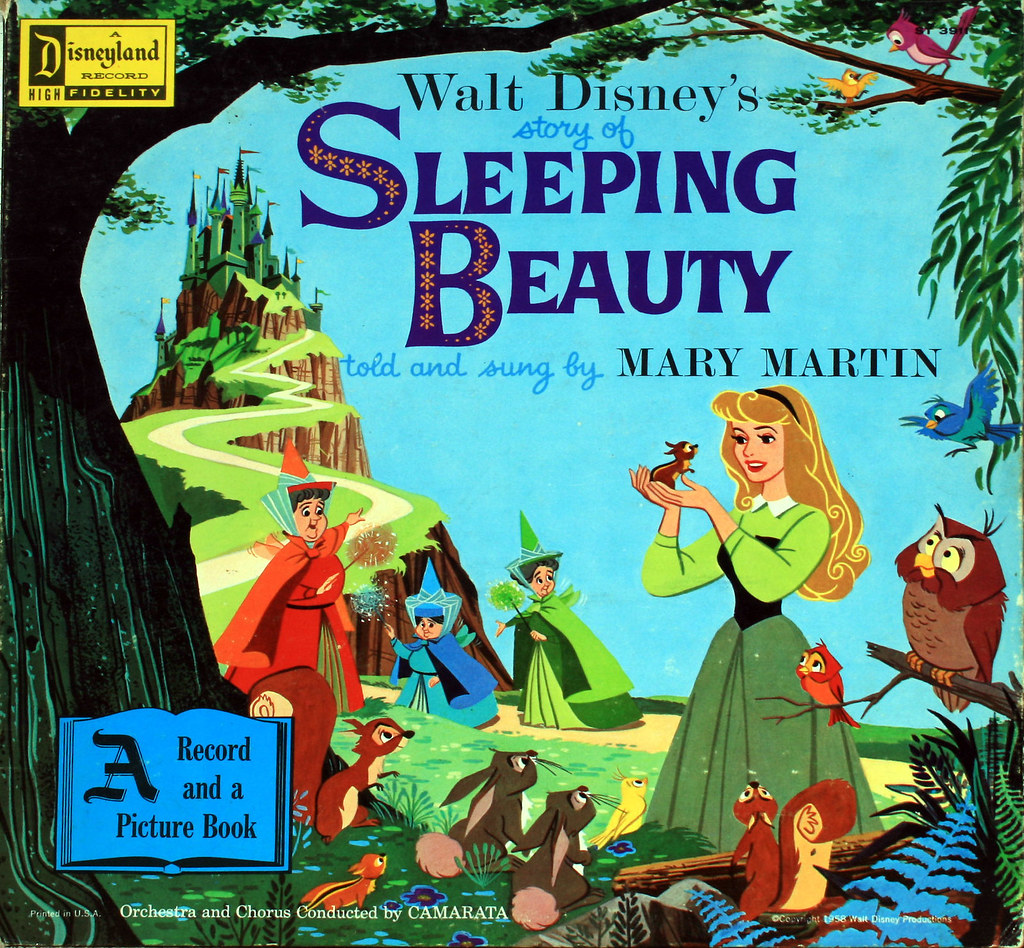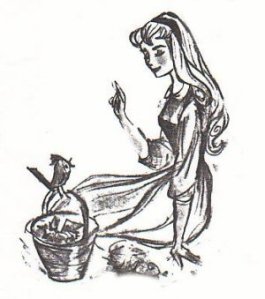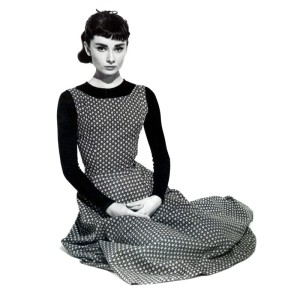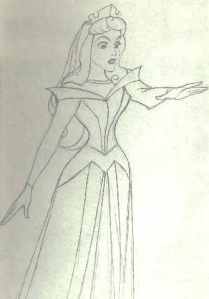
Commentaries given by:
- Jeff Kurtti - Disney historian and narrator
- Eyvind Earle - Art Director for Sleeping Beauty
- Marc Davis - Supervising animator for Princess Aurora/Briar Rose & Maleficent
- Frank Armitage - Background artist
- Mary Costa, Voice of Princess Aurora/Briar Rose
- Mike Gabriel - Disney artist, Inspired by film.
- Mike Giaimo - Disney artist, Inspired by film.
- Ollie Johnston - Supervising animator for Flora, Fauna & Merryweather
- Frank Thomas - Supervising animator for Flora, Fauna & Merryweather
Article Interview by Marc Davishttp://www.medievalcottage.com/sbdavis.html





Here's a couple of great images of Princess Aurora from a book from the Story Hour Series that was published in 1959. She looks more like a 1950's debutant than the medieval princess we see in the film.

Several character studies of Briar Rose by Marc Davis.

Several character studies of Prince Phillip's fall into the stream.


An early concept drawing of the three good fairies: Flora, Fauna and Merryweather.

An early concept painting of the fairies. They look more themselves in this rendering. And, Fauna looks good in yellow, too!


Tom Oreb's early drawing of Sleeping Beauty, influenced by Audrey Hepburn

Audrey Hepburn
“The qualities of that actress’ slender, willowy physicality lend themselves beautifully to the design environment of the film,” said
drawing of Sleeping Beauty by Marc Davis, redesigned for use in 1959 film
Originally,” said Disney animator Ron Dias, “Sleeping Beauty looked a lot like Audrey Hepburn; she was softer, rounder, more like the ‘designy’ Disney girl. Back at the drawing board, Marc Davis redesigned her. She became very angular, moving with more fluidity and elegance, but her design had a harder line. The edges of her dress became squarer, pointed even, and the back of her head came almost to a point rather than round and cuddly like the other Disney girls. It had to be done to complement the background.”Click below to see Helene Stanley perform in the Disney Studio as the live action model for Sleeping Beauty as Disney artists sketch away. This video was part of the premiere of the Disneyland TV show.
Video Reference
As Frank Armitage states, "Well, the story takes place in the 14th century. That's the gothic period so the illuminated manuscripts and tapestries of the time, they are all used as a reference."
Surprisingly, Walt entrusted the entire film design to Eyvind, who came to the studio in 1951 after trying for years to get in. He was then exposed to the Disney artists' work (such as Mary Blair) and thought "Wow! That's the job I want."
Sleeping Beauty not only displayed a unique design, it also employed innovative special effects and processes in animation. This included "...elaborate camera processes, double exposure, special props and other technical wizardry." The birds-in-flight scene at the beginning of the film (when Fauna bestowed her gift) was actually airbrushed onto 12 foot silk sheets which were mounted onto rollers and made to move past the camera.
Eyvind Earle was also in charge of the color scheme for all of the character. With past films, the animator chose the color scheme that best suited their characters. But Earle believed that that color scheme of the picture should be consistent and that one person should be in charge of the characters' scheme as well. Marc Davis' early concept drawings of Maleficent shows her in black and red. Earle changed the color from red to lavender, which is what you see in the film today.
After Sleeping Beauty wrapped production, Eyvind Earle left the studios. He never blamed the other animators for the resistance he encountered during the film's production. He acknowledges that he was the new guy telling the old guys that their style was not working.

Of course, magic plays a very important role in the film, but no character has complete magic. Per Ollie Johnston, "Nobody can do everything with their magic." The animators had to really think about how to handle the fairies' magic and how to balance it out within the context of the story.
Out of all the characters in Sleeping Beauty, the three good fairies leaned the farthest away from Eyvind Earle's strict geometric design. Ollie Johnston and Frank Thomas would go to the supermarkets or parties and observe old ladies and how they acted, talked, walked, moved and handled objects. This helped develop the distinct personalities of Flora, Fauna and Merryweather.
Eyvind Earle and character designer, Tom Oreb, initially designed the three fairies as strict geometric shapes that represented square, triangle and circle. This really limited the creative performance of the characters. Their design was eventually softened.
All of the characters in Sleeping Beauty were designed to fit Eyvind Earle's strong backgrounds. The result was a real departure for Disney because up until then, Disney characters were soft and round, the "house style of Disney". Eyvind Earle really disliked this softness of design. This caused some tension as normally, the characters would be developed first and the background painted to compliment them. With Sleeping Beauty, the backgrounds dictated how the characters were designed.
Jeff Kurtti explains the character design best: "According to several sources, the design of the princess disguised as Briar Rose was based on the physical geometry of Audrey Hepburn. The qualities of that actress' slender, willowy physicality lend themselves beautifully to the design environment of the film. ...It's been said that the draftsmanship of the film was executed with such precision that many of the cleanup artists used protractors, rulers and t-squares."
Marc Davis understood Earle's vision, "...Not only was it [Sleeping Beauty] stylized, but that it had a style that belongs only to itself. The design of the characters, the design of the hair of the girl, the animals, are very stylized."
Walt Disney wanted this film to be a "moving illustration" and that is exactly what the artists and animators strived for.
So that the film wasn't strictly gothic in appearance, the artists introduced diagonal light sources and shadows to soften the look a bit. This is clearly illustrated in the forest scenes where the sunlight is shown filtering through the trees. This diagonal placement of the beams of light cut through the film's strict horizontal and vertical design and softens the overall composition.
Walt liked to re-use voice actors for his films. The women who provided the voices for the three good fairies were no exception. Verna Felton did the voice of Flora as well as an elephant in Dumbo, the Fairy Godmother in Cinderella, Aunt Sarah in Lady and the Trampand Winifred Elephant in The Jungle Book. Barbara Luddy who did the voice of Merryweather can also be heard as Lady in Lady and the Tramp, Kanga in Winnie the Pooh, and two characters in Robin Hood.
Walt Disney personally picked Eleanor Audley to do the voice of Maleficent after her successful voice work as the wicked stepmother in Cinderella.

Mary Costa reminisced about her role in Sleeping Beauty. She was picked to do the voice of Princess Aurora/ Briar Rose. She accepted an invitation to audition at the studios only because she wanted to meet Walt Disney. She wasn't too confident she would actually get the part. Costa, a native of Tennessee, had a strong southern accent. George Bruns, who was the music director, worked with Mary Costa to develop a more natural English accent. Mary Costa spoke the lines in a raised voice and a slight British accent by dropping the r's. Walt, who was hidden behind a screen, was impressed by what he heard and hired Costa to do both the singing and speaking parts. Consequently, Mary Costa was not to meet Walt Disney face-to-face until after the film was completed some 5 years later. When Mary Costa finally did have the pleasure of meeting Walt, she remembers fondly a conversation she had with him where she stated that "A bird doesn't sing because it's happy. It's happy because it sings!" This earned her the nickname "Happy Bird".
Also, Mary Costa spoke her lines as if reciting a musical passage. This gave the princess's voice a more melodic, fairy-tale quality.
It was Walt Disney's idea to have only three fairies in his version of the tale. Walt liked the idea of working with a trio of characters (a sort of mystical combination). A trio offered a "broad range" in which to work and develop the characters. His earlier shorts illustrate this with the use of Mickey, Donald & Goofy.
Earlier development of the fairies had them acting and behaving according to their names. "Flora was to have domain over the plants, Fauna over the animals, and Merryweather controlled the climate. Walt ultimately discarded this notion as he felt that it led the overall story nowhere." - Jeff Kurtti.

Walt Disney was distracted during the production of Sleeping Beauty by the planning and construction of Disneyland, and his foray into TV and live action films. Ollie Johnston recalls having difficulty getting Walt into the studio for input on the film. But, he acknowledges that Walt was still the "last word".
Walt really wanted to direct films and he was really instrumental in the expansion of the story of Sleeping Beauty. The fairies finding Prince Phillip's hat, the princess's journey home, and the declaration of the fairies going into the Forbidden Mountains were Walt's idea. He even supplied some of the dialog and worked with Ollie Johnston on the timing of the scenes. According to Ollie Johnston, "Walt was the driving force behind the film's final look and employing Eyvind Earle's style. The resulted is a more serious film..."
Sleeping Beauty was the end of an artistic era at the Disney Studios. It was the last Disney animated feature to use hand-inked cels where every animated drawing was transferred onto clear acetate by hand, usually using inks in a variety of colors. The feature films that followed made use of the Xerox copying process which transferred the cleaned up drawings of the animators directly onto the cels in black ink.
Walt Disney registered the title Sleeping Beauty with the Motion Picture Association of America on January 19, 1950, a month before the release of Cinderella. Work on Sleeping Beauty began in 1951 with a storyboard being completed in 1952. But, Walt and his artists were playing with the idea of making this film as early as the late 1930's. The 1952 storyboards of this film were quite different from what we see today. This film version had the Princess Aurora growing up in the castle as a "poor little rich girl... much like Princess Jasmine" in the much later film of Aladdin. The fairies were more gnome or pixie-like and drawn in the more soft "Disney house style". Walt apparently was not satisfied with this development and the team threw out this first storyboard and started over. What they developed then was what we see today, a "story that appears traditional, yet is distinctly Disney".
Ultimately, the finished film credits Charles Perrault's La Belle au Bois Dormant as its source. However, it is actually closer to the Brother Grimm's version Little Briar Rose. The film version merely kept the "bare-bones" of the original tale.
Walt Disney wanted to make this, his third fairy tale, different from the previous two (Cinderella and Snow White and the Seven Dwarfs). He was challenged to make this fairy tale princess different. It was Walt's idea to have the princess remain unaware of the curse and the danger that hung over her. "The princess was then able to act on her own accord and not act according to her predicament". As a result, the princess's personality became different and more modern than the princesses the preceded her.

Also, the studio's talents were at its peak during the development of this film. Walt, himself, felt confident enough in his team for them to expand the role of the prince in this story. Walt not only wanted the prince's role expanded, but also wanted the prince's personality enhanced. The princes from Cinderella and Snow White had very small roles and less screen time due to the studio's "questionable draftsmanship" of such difficult characters. Milt Kahl was eventually put in charge of animating the more dimensional prince in Sleeping Beauty.
The music of the film was adopted from Tchaikowsky's The Sleeping Beauty Ballet. Initially, there was a hesitancy to use the Tchaikowsky score due to the negative feedback and criticism that was generated from the release of Fantasia and its musical alteration of classic scores. But Walt decided to go ahead with the Tchaikowsky score claiming "...people have been stealing from Tchaikowsky for years...". George Bruns' adoption of this score earned the studio an Oscar nomination for "Best Score" in 1960.
The Disney team spent more time working on this film than any other film. Ollie Johnston began to tire of it. He found that his appreciation for it grew after he had returned to it after distancing himself from it for some time.
Sleeping Beauty was also the only film at the time to be filmed in wide screen. The wide screen process more closely dictate what we see by presenting the images in a 2 1/2 to 1 aspect ratio (think rectangle instead of square). The standard square shaped screen is akin to looking out a window. Sleeping Beauty was shot in 70mm and was designed from the start to take advantage of the wide screen. This proved more work from everyone in the studio, not just the animators who had to fill the space with their characters, or the background artists who had to produce twice the art to fill the wide space. The layout department also had their work increased by having to closely examine the staging and camera movements. The Disney studio would not return to this type of filming until the 1985 release of The Black Cauldron.
It's been said that Sleeping Beauty contains some of the most frightening images in a Disney movie. Walt Disney was not so worried about whether or not a scene was too intense or scary for his audience. "He knew that only with a true threat can a hero or heroine achieve a true victory." - Jeff Kurtti
Walt knew how to tell a good story. However, Disney is often criticized for his retelling of ancient tales and his stories are often tagged as being "Disneyfied". But Walt was only doing what storytellers have been doing for centuries, and this is to adapt stories based on the "cultural need" of the time. Tom Schumacher said "Storytellers for all time have taken core story material and adopted it and changed it for their audience, their era and their point of view".
As Mike Gabriel puts it "You can't argue Sleeping Beauty's world. It's a beautiful world, it's an enchanted world, it's a world that you would love to be in yourself. Through design and color it takes you to other places that you've never been to before." And that is its special appeal.

Nessun commento:
Posta un commento